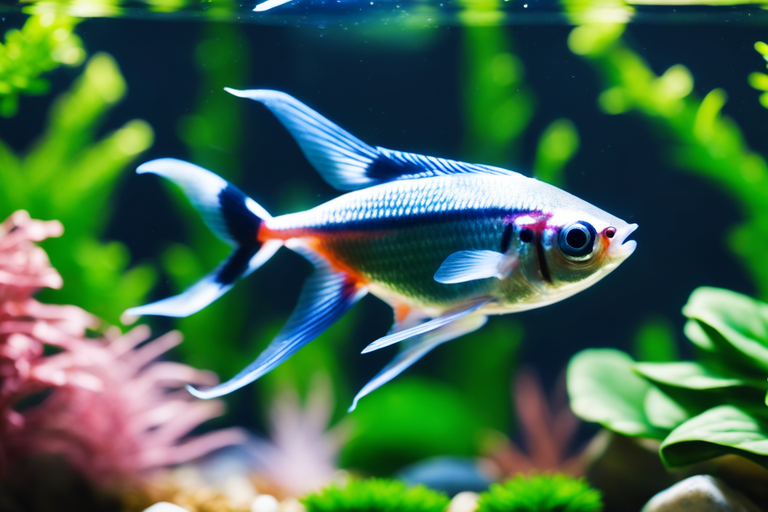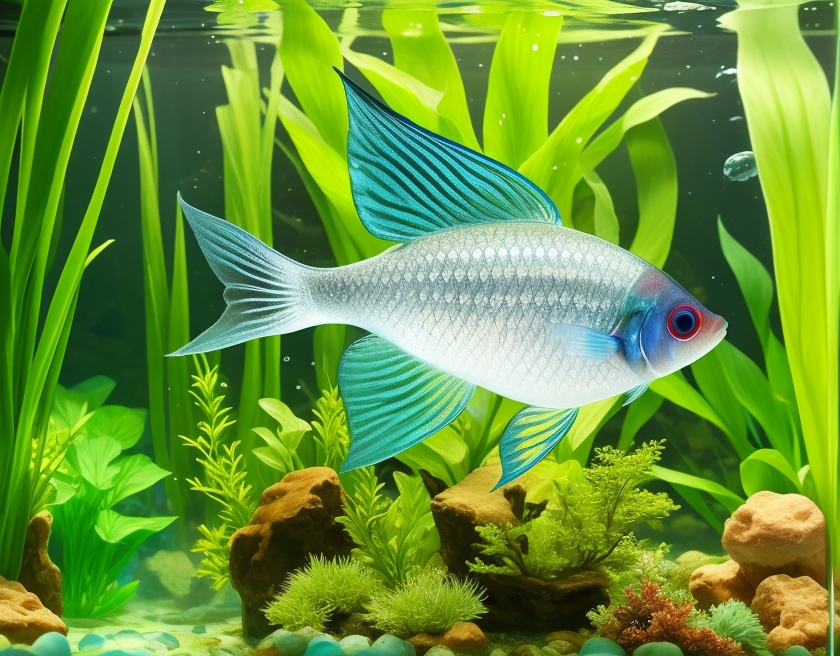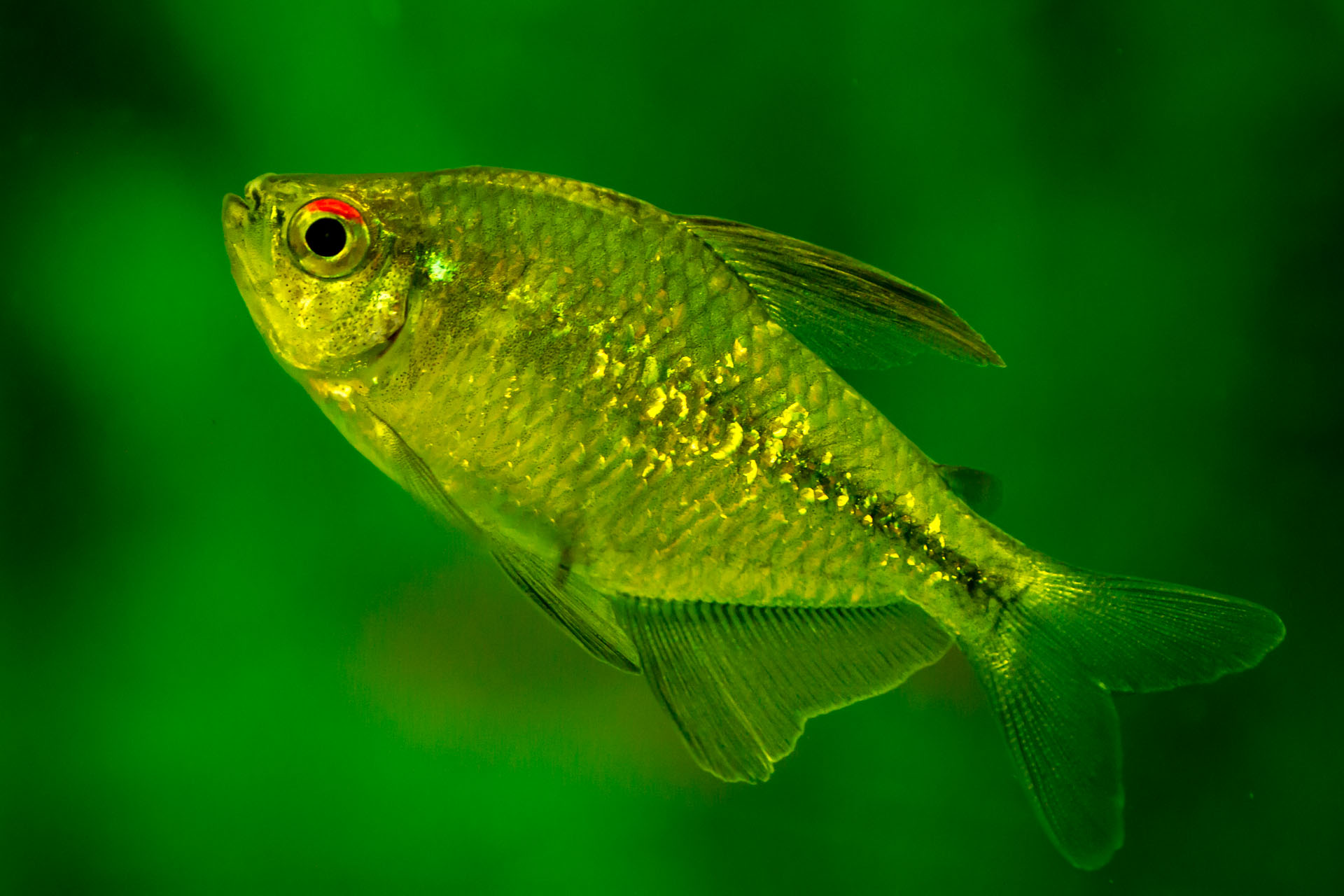Are you looking to learn more about keeping diamond tetras in your aquarium? This complete care guide is here to provide you with detailed, knowledgeable information on everything you need to know.
From tank requirements and diet to tank mates and breeding, you’ll be expertly guided every step of the way.
Let’s dive in and explore the wonderful world of diamond tetras!
They are well-suited to captivity and are considered beginner-friendly due to their low maintenance needs, making them a popular choice among aquarists1. Here are some quick facts about Diamond Tetras:
- Size and Appearance:
- They grow to about 2 to 2.4 inches in length23.
- Known for their iridescent scales that have a shimmering effect, especially beautiful under dim light1.
- They have a silver body with purple dorsal and anal fins. A noticeable red mark is found above the pupil of their eyes, alongside a dark stripe running down their body midline4.
- Habitat and Care:
- Native to Lake Valencia, Venezuela, they thrive in groups of at least 5 and require a tank size of 31 inches or larger5.
- They prefer soft, slightly acidic water with pH levels between 6.0 to 7.0 and temperatures between 75°F to 82°F5.
- Being omnivores, their diet includes worms, crustaceans, and insects5.
- Behavior and Compatibility:
- Lifespan:
- They have a lifespan of between 3 to 6 years, which can be extended with good water conditions and proper care1
- Breeding:
- Males have a long and pointed dorsal fin, whereas females have a short dorsal fin, aiding in gender identification for breeding purposes1.
- Scientific Classification:
- Kingdom: Animalia
- Phylum: Chordata
- Class: Actinopterygii
- Order: Characiformes
- Family: Characidae
- Genus: Moenkhausia
- Species: pittieri1.
These quick facts provide a glimpse into the characteristics and care requirements for Diamond Tetras, making them a delightful addition to community aquariums for both novice and experienced fish keepers.
Overview and Quick facts
Get to know the basics of the diamond tetra with this overview and quick facts.
The diamond tetra (Moenkhausia pittieri) is a small species of fish that originates in the Orinoco and Amazon river basins in South America. It’s a peaceful and hardy fish that’s suitable to most community aquariums and is particularly popular with beginner aquarists.
The diamond tetra has a long, slender body with a large head and a shimmering, diamond-patterned body. It’s a schooling fish that’s best kept in groups of at least six. It’s also important to note that Diamond tetras have similarities in breeding and are quite easy to breed in captivity.
In terms of tank décor, the Diamond tetra prefers a densely planted aquarium with plenty of hiding places. The tank should also have plenty of swimming space and a darker substrate to bring out the fish’s colors. It’s also important to remember that the diamond tetra is sensitive to water quality, so regular water changes are necessary.
All in all, the diamond tetra is an ideal fish for beginner aquarists looking for a colorful and peaceful species to add to their aquarium.

Appearance & Behavior
Learn about the physical appearance and behavior of the diamond tetra so you can better understand this peaceful and hardy fish.
The diamond tetra has a slender, elongated body that’s light silver in color, with a pink, iridescent stripe running from the head to the tail. It has a black line along the dorsal fin and another along the lateral side. The diamond tetra also has a bright yellow spot near its tail fin.
When swimming, the diamond tetra moves in an erratic pattern. It will dart around the tank, its fins fluttering to propel it forward. Its body color allows it to blend in with its environment, making it difficult for predators to spot.
The diamond tetra is a peaceful fish that can live happily with other compatible species. With its impressive colors and active swimming, the diamond tetra is a beautiful addition to your tank. With proper care, your diamond tetra will have a long and healthy life.
Now that you know about the physical appearance and behavior of the diamond tetra, it’s time to move on to the next section about care and tank requirements.
Care and tank requirements
Gain insight into the care and tank requirements of the diamond tetra to ensure it has a long and healthy life.
Maintaining the tank water pH levels is essential; they should stay between 6.5 and 7.5 for the best results. Ammonia and nitrate levels should be tested weekly to make sure they remain low and, if needed, use a water conditioner to help control the levels. Cleaning the tank should be done on a regular basis. A partial water change of 25 percent should occur every two weeks and a full water change of 50 percent should occur every four weeks.

Lighting levels are also important for diamond tetras. These fish require a moderate amount of light. A light cycle of 10-12 hours a day is ideal. To control the lighting, an adjustable timer can be used. This will help to create a natural day/night cycle that the fish can adjust to. Additionally, the lights should be dimmed during the night cycle to help the fish rest and recharge.
Having the right tank size is also important for diamond tetras. A 10-gallon tank is suitable for a small group of these fish. However, larger groups should have a 20-gallon tank to provide enough space for them to move around. The tank should be decorated with plenty of plants and hiding spots to offer the fish a sense of security.
Tank Mates
You can also consider adding tank mates for your diamond tetra, but make sure they’re compatible with each other. To find compatible tank mates, consider the water parameters, pH levels, and size of your diamond tetra. Other peaceful fish species that can live harmoniously with your diamond tetra include:
- Other small tetra species: Examples include neon tetras, black skirt tetras, ember tetras, or glowlight tetras. These small and active fish will create a beautiful school of color in your tank.
- Rasboras: Harlequin rasboras or chili rasboras make good companions for diamond tetras due to their similar size and behavior.
- Corydoras catfish: Bottom-dwelling Corydoras catfish like the bronze cory or panda cory can coexist peacefully with diamond tetras while keeping the aquarium clean by scavenging leftover food on the substrate.
- Dwarf shrimp: If you have plenty of hiding spots in the aquarium, such as plants or caves, you can consider adding some dwarf shrimp like cherry shrimp or amano shrimp as they won’t harm each other.
Avoid adding aggressive fish like bettas or larger fin-nipping species to prevent any conflicts with the diamond tetras. It’s important to research individual species compatibility before introducing them into your tank. Keeping appropriate water parameters (temperature range between 72°F – 79°F) and providing ample hiding places will contribute to a harmonious community setup for your diamond tetrax.
These fish have similar tank set up requirements as the diamond tetra so it’s best to keep them in the same tank. However, be sure to research each fish species to ensure they can all live together in harmony. Additionally, you should also factor in the number of fish in the tank, as overcrowding can cause stress or aggression.
Once you’ve established which fish are compatible with your diamond tetras, you can move on to the next step of establishing their diet and feeding routine.
Diet and Feeding
Gaining a better understanding of your diamond tetra’s diet and feeding routine is essential for its health. With this in mind, it’s important to recognize what types of food are best for this fish, as well as how often it should be fed.
In terms of food types, diamond tetras feed on small live and frozen foods, such as bloodworms, brine shrimp, and daphnia. They also enjoy high-quality flake and pellet foods. It’s important to feed your diamond tetra a variety of these foods for a balanced diet.
In terms of how often you should feed your diamond tetra, it’s best to feed it small amounts two to three times a day. Overfeeding the fish can lead to health issues, such as swim bladder disease and obesity. An easy way to avoid this is to feed your diamond tetra an amount that it can consume within two minutes. After two minutes, remove any uneaten food with a net. This will ensure that your diamond tetra doesn’t overeat.
Breeding
You’ll need to provide optimal conditions if you want your diamond tetra to breed successfully. To encourage them to mate, you’ll need to create an environment in which they feel safe and comfortable. This can be achieved through appropriate aquarium decor and good water conditions. Here are some tips for breeding diamond tetras:
- Prepare the aquarium by adding some floating plants and hiding spots. These will help provide the fish with the security they need to initiate the breeding process.
- Provide an adequate temperature for breeding. Diamond tetras prefer a temperature between 73 to 82 degrees Fahrenheit.
- Make sure the water is clean and well-oxygenated. A water temperature between 75 to 79 degrees Fahrenheit and a pH level of 6.5 to 7.5 is ideal.
- Increase the aquarium’s lighting to simulate a natural day/night cycle. This will help trigger the diamond tetras to breed.
By following these tips, you can create a safe and secure environment that will encourage your diamond tetras to breed.
Keep in mind that the breeding process can be difficult to accomplish, so make sure you’re well-prepared and have patience. With the right conditions, however, you can expect to have a successful breeding process.
Conclusion
You now have a good understanding of the diamond tetra and how to care for it. With the right tank requirements, tank mates, and diet, you can provide a healthy and happy environment for your diamond tetra.
Remember to stay patient and observant when breeding, and you’ll soon be rewarded with the sight of many new diamond tetra swimming in your tank.

